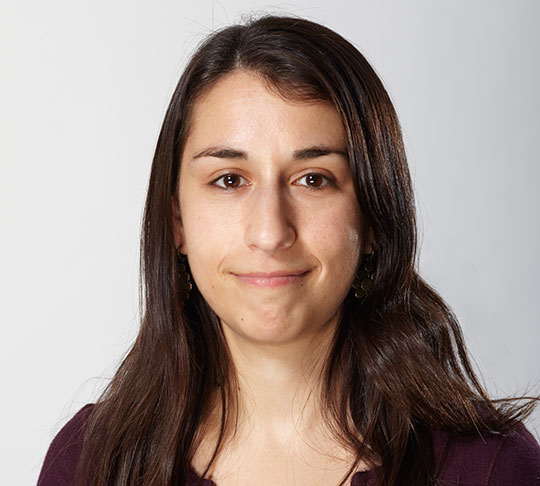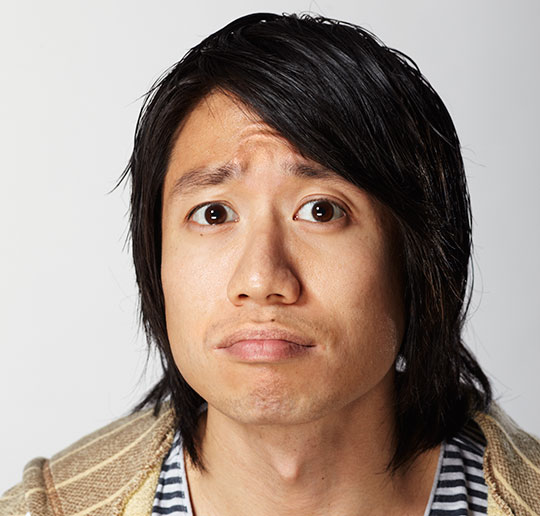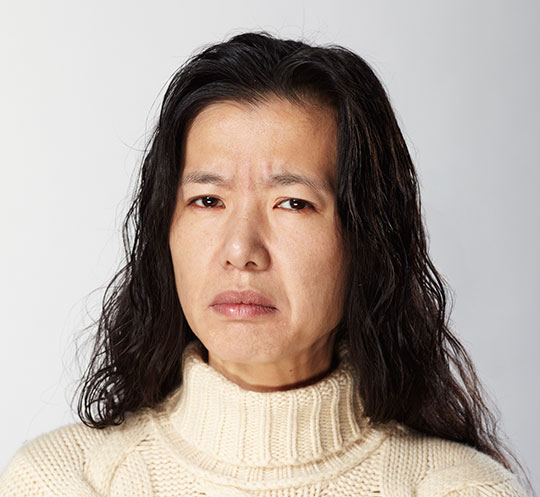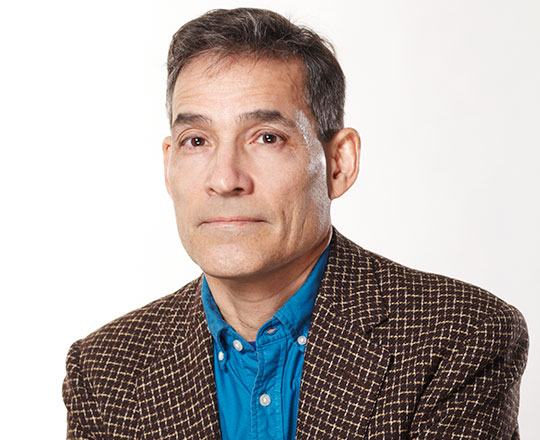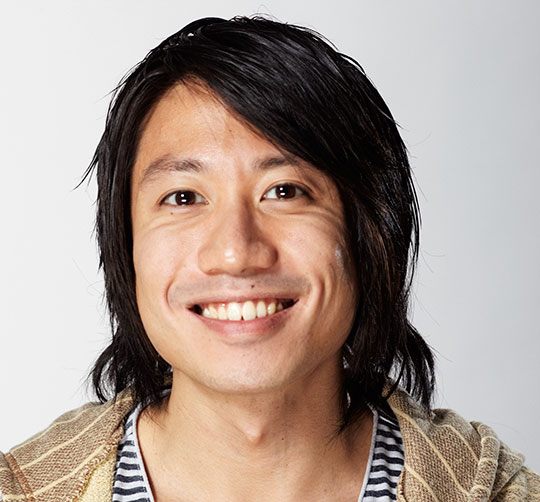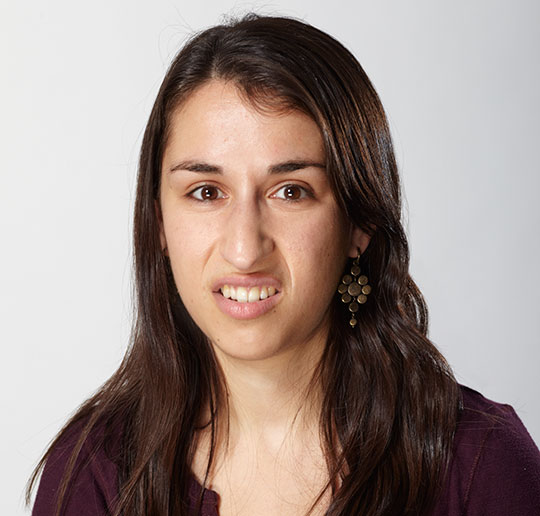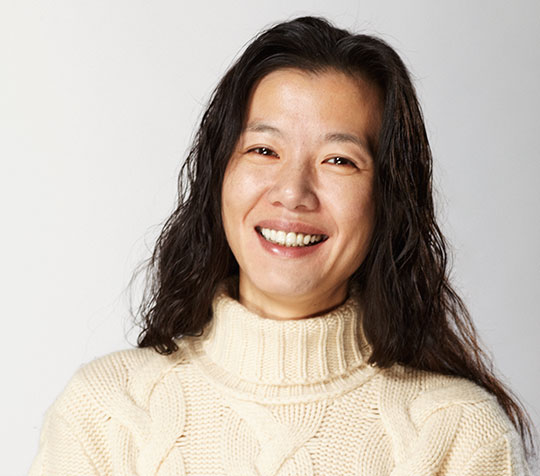The New Face of Sadness
George Bonanno has redefined our thinking about grief and resilience
George Bonanno has redefined our thinking about grief and resilience
By Joe Levine
Photography by SAMANTHA ISOM
“These images are indelible -- they’ll be with us all our lives.”
George Bonanno, a TC psychologist and perhaps the world’s most visible expert on resilience to grief and trauma, is speaking in the College’s Milbank Chapel on the 10th anniversary of the 9/11 terrorist attacks. Soon people will stand to speak the names of family and friends who died in the attacks, but Bonanno, 55, a slim man with boyish good looks and an air of bemused gentleness, pulls no punches. He takes the audience through that day’s most horrific scenes. The trapped people gesturing from 100th-floor windows; the towers enveloped in smoke and flame; rescue workers picking through smoking ruins.
The screen goes blank, and Bonanno begins to talk about what we have learned from 9/11. One lesson is certainly that bad things happen. “Most of the world knew it, but there was a sense in the U. S. that we were invulnerable.” Another, without a doubt, is that disasters cause serious harm, both physical and psychological.
Yet 9/11 also confirmed that most people can cope with even the most harrowing circumstances. In a study of some 2,700 New Yorkers published by Bonanno and other researchers six months after the attacks, more than two-thirds of those interviewed showed virtually no sign of post-traumatic stress disorder (PTSD). Across racial, ethnic and socioeconomic lines, the prevalence of resilience was more than 50 percent and never fell below one-third, even in people who had been inside the towers, sustained physical injury or seen friends die.
The Milbank audience murmurs its surprise, but Bonanno isn’t finished. He shows a graph with three lines on it. One, labeled “chronic grief,” starts high on the graph and stays there. Another, labeled “recovery,” starts equally high but makes its way downward in fits and starts. The third, labeled “resilience,” begins low, drops sharply and quickly levels out to near flatness.
Until recently, Bonanno says, most experts believed that normal grieving looked like the “recovery” graph, a process conducted in stages, requiring hard work by the bereaved person to reach a “successful” resolution. But the experts were wrong. He and others have shown that that nearly level line represents most people’s reactions to adverse events, ranging from personal loss to witnessing violent trauma.
“The resilient response predominates,” Bonanno says. “We’re stronger than we realized.”
A man for his time
Every age has its disasters, but the 21st century seems to have arrived with biblical ferocity: 9/11; SARS; hurricane Katrina; the tsunami in Southeast Asia; the triple disaster in Japan. In this scary new world, George Bonanno seems to be the man most called upon to respond to the question, “how’re we doin’?” He has written for Newsweek on the endurance of the Japanese; appeared on CNN after the Chilean miners were rescued; opined in The Boston Globe on the psychological prospects of Katrina survivors. His breakout 2009 book, The Other Side of Sadness: What the New Science of Bereavement Tells Us About Life After Loss, was reviewed in The New York Times and The New Yorker.
In studies running the gamut from children with AIDS to survivors of oil rig disasters, Bonanno’s message—that, for the most part, we can handle it—has been “a game changer,” as Harvard psychologist Daniel Gilbert declares on the cover of The Other Side of Sadness, showing that “most of what we thought we knew is just plain wrong.”
“Sadness and fear aren’t accidental by-products—they are evolved responses with highly adaptive functions,” Bonanno told me this fall over lunch at his favorite Korean restaurant. He has a fondness for things Asian, from vaguely Nehru-style jackets to Buddhism and Chinese ancestor rites. “Sadness draws our attention inward and allows us to temporarily tune the world out. Our heart rate slows, we take stock and recalibrate. We’ve lost something—someone—and we can’t use them anymore to regulate ourselves.” He put down his chopsticks and leaned forward to emphasize his point. “Throughout the day I see things that I imagine telling my wife. If she died, I would edit that impulse over time. And it wouldn’t be about simply accepting that she was gone—it’s an actual reconfiguring of the brain. You know the expression ‘sadder but wiser’? That’s really what it means.”
Sadness also cues other people to our needs, eliciting their sympathy and, often, their help. “I’ve always found room for optimism in these observations,” Bonanno writes in The Other Side of Sadness. “Sure, we can list the horrors humans have inflicted on each other… But it’s a hopeful sign that we seem to be wired, from the cradle to the grave, to respond with sympathy when others suffer.”
Still, Bonanno is no feel-good pop psychologist. His ideas, he says, are simply the result of applying standard psychological methods to assumptions that, oddly, no one had previously tested. Take the notion that grieving occurs in stages, which has grown out of Elisabeth Kubler-Ross’s model for how terminally ill people accept the inevitability of their own death. If that idea is accurate—if grief immediately after losing a loved one is the all-engulfing experience assumed by many experts and therapists—then people in its earliest stages should be incapable of smiling or laughter. Yet Bonanno has shown that’s not the case. He and his students have videotaped and transcribed interviews with thousands of recently bereaved people or people exposed to violent trauma; compared their descriptions of those experiences to how they talked about other life events; and analyzed their facial expressions and measured their heart rates, blood pressure and other nervous system activity while they spoke. The focus on facial expression is critical, because the face does not lie. When a person flashes a genuine smile, certain eye muscles come into play, a phenomenon identified by 19th-century physician Guillaume Duchenne. By coding interviews for Duchenne smiling, Bonanno has demonstrated not only that laughter and smiling are normal even in the days immediately following loss, but also that recently bereaved people who display “context sensitivity”—that is, who can smile or laugh at something funny or pleasurable and look sad in response to something that is, in fact, sad—resume normal functioning sooner and prove more resilient long term.
In fact, Bonanno asserts, grieving, for most of us, is an “oscillation,” in which overwhelming sadness alternates with other, more everyday emotions. Freud’s notion of “grief work”—an exhaustive process of reliving memories in order to shed them—is misguided, because it can only imprint memory more deeply. There is no such thing as “insufficient mourning,” “failure to mourn,” or “delayed grief,” and maintaining an emotional connection with the dead can be beneficial. One woman he describes, a journalist named Sondra Singer Beaulieu, reports being visited repeatedly by her late husband, Serge. The couple had been work partners, and Sondra initially struggled with guilt over her inability to finish Serge’s projects and carry on his legacy. One night “she woke up and saw Serge standing in the bedroom doorway… She was left with a lingering conviction that Serge had visited her to assess the situation.”
After a second such “visit,” Sondra wrote, in a personal essay, “I sensed that Serge was telling me that he was in this extraordinary, tranquil place and that he was all right. He had no worries about what was happening here, and no matter what I was able to do—or not do—it was all right.”
From “a traditional perspective,” Bonanno writes, Sondra’s “quasi-hallucinatory exchanges with Serge could only mean trouble.” Conventional wisdom would hold that she was “using the enduring bond as some sort of fantasy experience to mask a deeper pain.” But Bonanno pronounces Sondra “unquestionably resilient,” informing us that she “basked in old friendships and began new ones… resumed her writing career” and, in general, “continued to live a rewarding and productive life.” Nor, he tells us, is her experience uncommon. Recent studies have found that most people who have lost loved ones feel watched over by them in some way. About one-third report talking regularly with the person they have lost, and some sense the dead person’s presence. The question of what’s real is largely irrelevant.
“It feels as if I’m with him when we talk,” says another woman profiled in Bonanno’s book. “That’s all that matters.”
The tracks of his tears
Bonanno’s own education about sadness—and emotions in general—seems to have unfolded on two tracks.
In his professional life, serendipity played a large role. After finishing graduate school, he was offered a job at the University of California, San Francisco, running some studies on bereavement. The topic seemed “a little creepy,” he says, “but I had just gotten married, San Francisco seemed like a nice place to be, and I was offered carte blanche to run the trials however I wanted.”
In San Francisco, Bonanno met a young psychologist, Dacher Keltner, and Keltner’s mentor, Paul Ekman, who had pioneered in demonstrating that, far from being some vestigial annoyance, emotions are varied, complex and useful, and that the ability to communicate emotional nuance is a vital human function. Bonanno and Keltner became frequent research collaborators, with grief and resilience as their focus.
“There seemed to be so much we could do, so many angles to explore,” Bonanno writes. “Almost nothing was known about how emotion worked during bereavement, and there were so many questions.”
But on a personal level, Bonanno’s deepening involvement with bereavement can be seen as part of a larger odyssey. He grew up in suburban Chicago as the oddball in a family of nonintellectuals—a reader, painter and musician, but also a rebel who hung out with troublemakers and barely finished high school.
He feuded with his father, a man with no formal education who had worked his way up to become head of Midwest distribution for Eastman Kodak. Profoundly insecure in his high-powered job, the elder Bonanno worked too hard, was chronically depressed and suffered a series of heart attacks that began when he was 43.
Tensions between father and son came to a head when Bonanno left home at 17.
“My dad had always wanted to travel, but couldn’t because he had to take care of his parents, who were immigrants,” Bonanno says. “My leaving was partly a result of intuiting that desire. He forbade me to do it, but I left anyway.”
Bonanno went out West, played music, worked as a sign painter and fruit picker, and stumbled into the mental health field when he was hired as a handyman by a group home in Boulder, Colorado, that offered juvenile offenders an alternative to jail.
“I found it easy to talk to the kids—I had long hair. The counselors decided to assign kids to me when they broke something, and soon I had a whole group of kids working with me.”
He followed that experience with a series of similar jobs—recreation director at an old age home; building a sheep barn with mentally handicapped adults—and thought about becoming a psychologist, but worried he was too old to go back to school.
And then his father died, the rift between them unhealed.
“I didn’t grieve a lot when it happened,” Bonanno says, “though I had thought I would—I knew that he was in bad health and would die prematurely. But instead, what I really felt was relief. I realized his death freed him from the suffering he’d gone through.”
It freed Bonanno, too. Two years later, at 26, he enrolled at the University of Massachusetts. After a year, he argued his way into a scholarship at nearby Hampshire College, where the classes were smaller, and went on to earn a Ph.D. at Yale.
“My life opened up,” he writes in The Other Side of Sadness. “I had been acting out a kind of duet with my father under bright lights in the center of the stage. The rest of the theater was dark. I could not see the faces in the audience. When my father died, it was if the house lights had come on. To my surprise, I found that the theater was empty. Not only was I the only one left on the stage, but I was the only person in the entire theater. I had been acting out a play by myself. I could have stopped at any point, but I hadn’t known it.”
And yet, though he didn’t grieve, Bonanno continued to work out the nuances of his past.
“I have, in fact, periodically engaged in something of a continued relationship with my father,” he writes. “As I grew older, I found myself having conversations with him—much to my amazement.” The first exchange took place while Bonanno was in graduate school at Yale. He was aware of wanting his father to know that he had turned out OK; that he held nothing against him. “I wanted so much to speak with him, to tell him these things. Then one day, while walking down a quiet street at dusk, I did… I looked around to double-check: Nobody was there; nobody was watching me. I spoke at a normal conversational level. ‘Hello, Dad,’ I began, and then I paused. I didn’t hear anything, but I felt my father’s presence. It was warm and comforting.”
The other 15 percent
This past September, Bonanno received a grant of just under $3 million from the National Institutes of Health to try to tease out the factors that, in about 10 percent of the population, result in prolonged grief (PG). People with this condition, which is something quite distinct from depression, can become socially isolated, suffer from immune system disorders and lose their ability to work. Some never recover.
To understand who is vulnerable to prolonged grief and why, Bonanno and his students are again videotaping recently bereaved people in their Loss, Trauma and Emotion Lab, a small suite of rooms on the fourth floor of TC’s Horace Mann Hall. In interviews conducted at 2, 14 and 25 months after the loss of a spouse, participants report on their own well-being. They perform certain computer tasks, one of which is viewing pictures with emotional content depicting positive and negative events, after which they are asked to heighten or suppress any expression of emotion. Subsequently they visit the lab of TC professor Karen Froud to undergo an electroencephalogram (EEG), a test that can detect electrical energy spikes in the brain that occur within fractions of a second after an emotional prompt, such as a sad image.
The study seeks to validate a number of Bonanno’s working hypotheses about emotional resilience. Does context sensitivity—being able to respond to different kinds of emotional prompts with appropriate facial expressions—really predict a better recovery from loss? Is there a distinctive pattern of brain response in people with PG—a biological marker that can predict who is most at risk? Identifying such correlations would help create an earlier, more consistent diagnosis, and perhaps also convince a skeptical medical establishment (and insurance industry) that PG is a bona fide condition with serious consequences.
But are there treatments that could help? There is no pill or simple codified procedure, but successful approaches have centered on understanding “those aspects of the loss or the lost relationship that most haunt the bereaved survivor,” Bonanno writes.
A therapist can help a patient see the fallacies in narratives of guilt and regret and also “develop concrete goals to begin moving back toward a normal life.”
Yet for Bonanno, culture may be the most profound mediator of grief. In his view, Western culture (primarily that of Europe and North America) tends to overvalue the feelings of individuals, while “people in non-Western cultures… care more about the interactions between people than about what is going on in any one person’s head.” For them, bereavement “is less about sadness and grief and more about what people do, whether they behave the way mourning people are supposed to behave.”
The ritualized forms of mourning that exist in many non-Western nations have a transformative power, strengthening community and family bonds. At the end of The Other Side of Sadness, Bonanno describes a trip he took in 2004 to China, where he had studied bereavement ritual extensively. Walking through Shau Kei Wan village on Hong Kong Island, he finally decides, after much hesitation, to observe the ancient tradition of burning a paper offering to his father. The choice of what, specifically, to burn seems momentous, until, watching his young daughter become entranced by shiny paper goods in a store, he hits upon the perfect solution: paper gold bullion.
“My father had worked hard all his life… so that his family could have a better life, and he had denied himself material pleasures… Gold was rock solid. This was something my father could rely on; this would make him feel safe, allow him to breathe a little easier… And then I realized that thinking about my father this way was the whole point. The insight was exhilarating.”
Completing the ritual, Bonanno felt something shift in his communion with his father.
“The words I had spoken were surprisingly forceful, as if I had summoned some great power… When I had spoken with my father previously, I had always imagined him alone. In the Man Mo Temple, I saw him in a world full of other people. They were amorphous, not fully realized, but… I was connected automatically, to all of them. Whatever my father was—a spirit, a memory, a cluster of neurons activated in my brain, a vague opening in the cosmos—it just didn’t matter. All that I cared about at that moment was that I felt deeply and immutably bonded with him…
“Then it struck me, right then and there, like a thunderbolt… I was reaching out to my father from a temple in China… In the context of my relationship with my father, it was enormous. My father had given up his desire to travel so that he could support his family. I had defiantly left home at a young age with the irrepressible intent to do just the opposite. This issue had torn us asunder; now it was the ground on which we were coming together.
“This was the best offering I could have hoped for.
“Before I knew it, the words came out of my mouth: ‘Ni hao, Dad.’ I couldn’t speak Chinese, but I knew how to say hello.”
Published Thursday, Dec. 15, 2011
